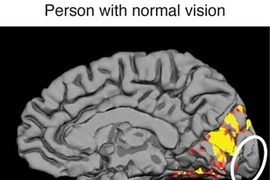The McGovern Institute for Brain Research at MIT, a leading research and teaching institute committed to advancing understanding of the human mind and communications, announced today that scientists have discovered the first evidence that brain reorganization occurs in people suffering from the progressive visual disorder macular degeneration.
The study, "Reorganization of Visual Processing in Macular Degeneration," was published in the Jan. 19 issue of The Journal of Neuroscience by MIT postdoctoral associate Chris Baker and Professor Nancy Kanwisher, in collaboration with Professor Eli Peli of the Schepens Eye Research Institute at Harvard Medical School.
Macular degeneration is the leading cause of blindness in the developed world, affecting more than 1.7 million people in the United States, and many millions of people worldwide. In macular degeneration, the center of the retina is damaged and sight is limited to peripheral vision. People suffering from this disease have blurry vision, which often causes severe difficulties with everyday tasks such as reading, driving and recognizing people.
"Our major finding is that the part of the brain that processes only central retinal visual information in people with normal sight reorganizes itself in people with macular degeneration to help process peripheral visual information," said Baker.
Using advanced brain imaging techniques and state-of-the-art retinal mapping techniques, the researchers monitored which parts of the brain process visual signals in people with macular degeneration compared to people with normal vision.
"While our findings do not have immediate clinical application, the fact that a larger region of the cortex is recruited for peripheral vision in people with macular degeneration is encouraging, and suggests that it may be possible to develop new rehabilitation strategies that exploit this increased cortical involvement to partially compensate for loss of retinal function," said Kanwisher.
The researchers plan to explore whether the brain reorganization enables people with the disease to see better with peripheral vision than other people, and to identify the conditions that lead to these changes in the brain.
A version of this article appeared in MIT Tech Talk on January 26, 2005 (download PDF).







